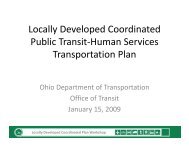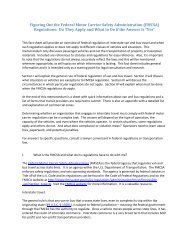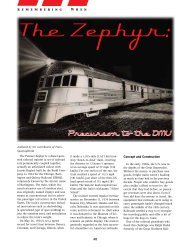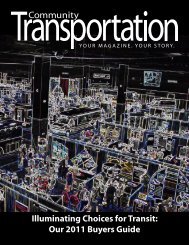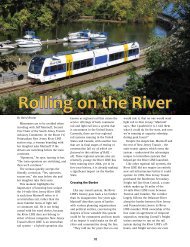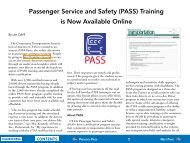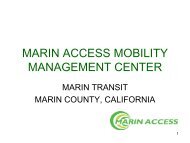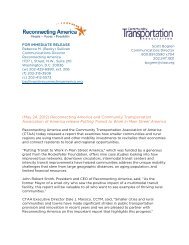San Luis Obispo - Caltrans - State of California
San Luis Obispo - Caltrans - State of California
San Luis Obispo - Caltrans - State of California
Create successful ePaper yourself
Turn your PDF publications into a flip-book with our unique Google optimized e-Paper software.
SAN LUIS OBISPO REGION<br />
COORDINATED HUMAN SERVICES-PUBLIC TRANSPORTATION PLAN<br />
coordination, as its role will vary with the nature <strong>of</strong> the strategy, plan or activity to be<br />
accomplished. This role will include but is not limited to, serving in a number <strong>of</strong> capacities as<br />
partner, broker and/or coordinator <strong>of</strong> projects, plans and programs. The Regional Mobility<br />
Manager with its multiplicity <strong>of</strong> roles must also serve as the “translator” and liaison between the<br />
two sectors toward the goal <strong>of</strong> improved mobility for the target populations.<br />
For the <strong>San</strong> <strong>Luis</strong> <strong>Obispo</strong> region, a single Regional Mobility Manager will provide leadership and<br />
promote dialog between the public transit operators and the human services agencies, as well<br />
as among the public operators themselves. Bridging the communication gap between the two<br />
systems is important and complicated as each speaks different languages and, to some degree,<br />
has different values. Further dialog among public transit operators is important as the plan<br />
speaks to the critical need for continued coordination among public transit services, as has been<br />
the direction <strong>of</strong> activities already undertaken. Coordinating public transit will go far in meeting<br />
some trip needs identified by this plan – for example, around transfer locations and timing <strong>of</strong><br />
connections, common core service hours and standardized fare policy and fare collection<br />
mechanisms.<br />
Given the complexities <strong>of</strong> this leadership role, the plan recommends that the Regional Mobility<br />
Manager be strongly affiliated with SLOCOG as the metropolitan planning organization.<br />
SLOCOG’s authority as the funding conduit for the public operators and its regional planning<br />
responsibility will help to support and realize the coordination opportunities this plan envisions.<br />
8.3.2 Ensuring a Strong Coordination Framework: Coordination Between Public Transit<br />
Providers<br />
Coordination also means coordination within systems, particularly within and between public<br />
transit systems. This introspective on coordination is equally important, especially for public<br />
transit whose sole business is to operate transportation services that should be seamless and<br />
transparent to the general public customers. Several recent initiatives, which have led to service<br />
improvements for the general public, have demonstrated potential for coordination between<br />
transit providers. Examples are;<br />
• Merging <strong>of</strong> two local fixed routes in North County for more direct connections between<br />
two cities (North County Shuttle, Aug. 06);<br />
• Shift <strong>of</strong> transit operations, dispatch and maintenance for several County Dial-A-ride<br />
systems under the RTA umbrella (South Bay and Nipomo DAR’s) with recent use <strong>of</strong><br />
Mobile Data Terminals (2007); and<br />
• Coordinated planning and implementation <strong>of</strong> regional and local bus service<br />
improvements (South County Area Transit timed transfer with regional buses since<br />
August 2007).<br />
Although, there are and have been coordination initiatives undertaken by the <strong>San</strong> <strong>Luis</strong> <strong>Obispo</strong><br />
region’s public transit operators, there remain opportunities to strengthen the public transit<br />
network and better serve consumers.<br />
For example, establishing core service operating hours across the region would benefit the<br />
transit dependent low-income rider who may need to travel long distances from home to work<br />
and back again, and must be certain that a return trip can be made. Other examples <strong>of</strong> potential<br />
areas <strong>of</strong> coordination could include standardization <strong>of</strong> age eligibility requirements between<br />
systems, more uniform fare media and coordinated scheduling and dispatching.<br />
117<br />
OCTOBER 2007



